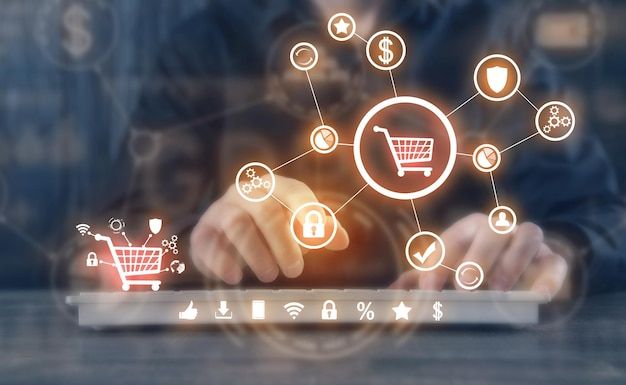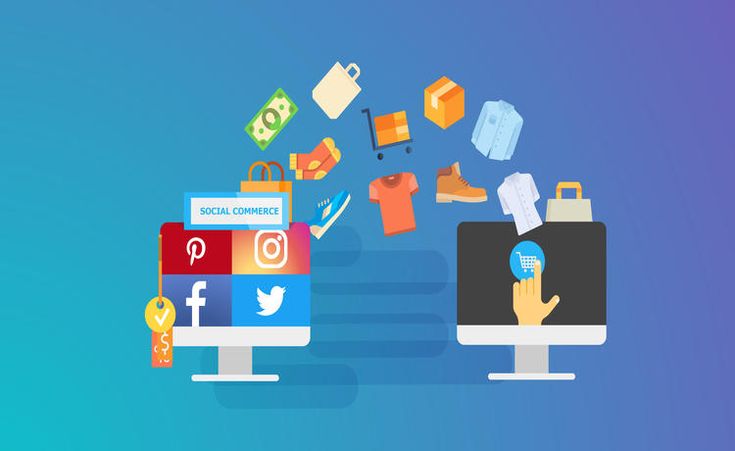The retail landscape has undergone a monumental transformation, with traditional brick-and-mortar stores increasingly sharing, and often ceding, dominance to online platforms. This pervasive shift, where e-commerce dominates retail, isn’t merely a trend; it’s a fundamental restructuring of how goods and services are bought and sold globally. Driven by technological advancements, evolving consumer behaviors, and the unparalleled convenience it offers, online commerce has grown from a nascent novelty into an indispensable pillar of the world economy. It has unveiled unprecedented opportunities for businesses, redefined consumer expectations, and catalyzed a continuous wave of innovation, profoundly impacting every facet of the retail sector worldwide.
The Genesis of a Revolution: From Catalogs to Clicks
To truly appreciate the current supremacy of e-commerce, it’s essential to understand its origins and the evolutionary steps that led to its global dominance. This journey spans decades, driven by technological breakthroughs and changing consumer habits.
A. Pre-Digital Retail: Brick-and-Mortar and Mail Order
Before the internet, retail was almost exclusively a physical experience, complemented by early forms of remote shopping.
- Traditional Brick-and-Mortar: The vast majority of commerce took place in physical stores. Consumers visited shops to browse, try on, and purchase goods. This model relied heavily on geographical proximity, limited operating hours, and significant overheads for physical spaces, staff, and inventory management.
- Mail Order Catalogs: A precursor to e-commerce, mail-order catalogs allowed consumers to browse products from a printed book and place orders via phone or mail. This offered convenience but lacked real-time inventory updates, immediate payment confirmation, and the rich interactivity of online platforms. Deliveries were slow, and returns cumbersome.
- Limited Reach: Both physical stores and mail order systems inherently had limited geographical reach. A store could only serve its immediate vicinity, and catalogs depended on physical distribution, restricting market penetration.
B. The Internet’s Infancy: Early Online Ventures
The advent of the internet in the 1990s laid the groundwork for e-commerce, though initial adoption was slow due to technical limitations and consumer skepticism.
- Emergence of the World Wide Web: The graphical web browser made the internet more accessible, transforming it from a niche academic tool into a public platform. This provided the visual interface needed for online shopping.
- Early Online Stores (1990s): Pioneering companies like Amazon (books) and eBay (auctions) demonstrated the viability of selling products online. These early platforms were often basic, with slow dial-up connections limiting rich content and complex interactions. Security concerns around online payments were also prevalent.
- Payment Processing Hurdles: Secure and reliable online payment gateways were a major challenge in the early days. Trust in credit card transactions over the internet was low, hindering widespread adoption.
- Logistical Complexities: Establishing efficient shipping, warehousing, and return processes for online orders was a new and formidable challenge for businesses used to traditional retail.
C. The Dot-Com Boom and Bust: Learning Curves
The late 1990s saw a speculative frenzy around internet companies, including e-commerce ventures.
- Unrealistic Expectations: Many start-ups focused on rapid growth without sustainable business models, leading to inflated valuations and unsustainable spending.
- The Bust: The dot-com bubble burst in the early 2000s, leading to the collapse of many e-commerce companies. This period, though painful, served as a crucial learning experience, weeding out unsustainable models and forcing a focus on profitability and robust infrastructure.
- Infrastructure Maturation: Despite the bust, the underlying internet infrastructure, payment systems, and logistical networks continued to mature, laying a stronger foundation for the next wave of e-commerce growth.
D. The Rise of Broadband and Mobile: Unleashing E-commerce’s Potential
The widespread adoption of broadband internet and the proliferation of smartphones were critical accelerators for e-commerce.
- High-Speed Connectivity: Broadband enabled richer content (high-resolution images, videos), faster page loading, and more complex interactive features, significantly enhancing the online shopping experience.
- Mobile Revolution: Smartphones put internet access and shopping capabilities directly into consumers’ pockets. Mobile apps, optimized for touchscreens and on-the-go Browse, made shopping ubiquitous and always accessible. This “m-commerce” became a dominant segment.
- Social Media Integration: Social platforms became new avenues for product discovery, marketing, and direct-to-consumer sales, leveraging influencer marketing and peer recommendations.
- Advanced Logistics and Supply Chains: Investments in sophisticated warehouse automation, last-mile delivery networks, and global fulfillment capabilities dramatically improved delivery speeds and reliability, addressing a key pain point for online shoppers.
This historical trajectory illustrates that e-commerce’s dominance is the culmination of decades of technological advancement, infrastructural investment, and a continuous adaptation to consumer needs and preferences.
Core Pillars of E-commerce Dominance: What Makes it Thrive
The success of e-commerce isn’t accidental; it’s built upon fundamental advantages and continuous innovation that cater directly to modern consumer and business demands.
A. Unparalleled Convenience and Accessibility
E-commerce offers a level of convenience and accessibility that traditional retail simply cannot match, profoundly impacting consumer behavior.
- 24/7 Availability: Online stores are always open, allowing consumers to shop anytime, anywhere, fitting into diverse lifestyles and time zones. This eliminates constraints of physical store hours.
- Global Reach: Consumers can access products from retailers across the globe, opening up a vast international marketplace that was previously inaccessible. Businesses, in turn, can reach customers far beyond their local storefront.
- Shop from Anywhere: Whether from home, during a commute, or on vacation, shopping is possible from any location with internet access, providing ultimate flexibility.
- Instant Gratification (Information): While physical delivery still takes time, the act of ordering and receiving confirmation is instant. Product information, reviews, and comparisons are available at the click of a button.
B. Extensive Product Selection and Variety
The digital shelf capacity of e-commerce vastly outperforms the physical limitations of brick-and-mortar stores.
- “Long Tail” Advantage: Online retailers can stock a virtually limitless array of products, including niche items that wouldn’t justify shelf space in a physical store. This caters to diverse and specialized consumer demands.
- Infinite Inventory: E-commerce platforms can display millions of products without being constrained by physical storage space, offering consumers an unparalleled choice.
- Easy Discovery: Advanced search filters, recommendation engines, and categorized Browse help consumers navigate vast product catalogs and discover new items relevant to their interests.
C. Competitive Pricing and Transparency
E-commerce fosters intense competition, leading to more transparent and often lower prices for consumers.
- Reduced Overhead: Online businesses often have lower overhead costs (no expensive retail leases, fewer sales staff) compared to physical stores, allowing them to pass savings onto consumers.
- Price Comparison: Consumers can easily compare prices from multiple retailers with a few clicks, driving down margins and forcing businesses to offer competitive pricing.
- Dynamic Pricing: E-commerce platforms can implement dynamic pricing strategies, adjusting prices in real-time based on demand, competition, and inventory, often leading to better deals for consumers.
- Flash Sales and Deals: The digital nature allows for rapid deployment of promotions, discounts, and flash sales, creating urgency and driving purchases.
D. Data-Driven Personalization and User Experience
E-commerce platforms leverage vast amounts of data to create highly personalized and intuitive shopping experiences.
- Recommendation Engines: AI-powered algorithms analyze past purchases, Browse history, and similar customer behavior to suggest relevant products, increasing sales and customer satisfaction (e.g., ‘Customers who bought this also bought…’).
- Personalized Marketing: Targeted advertisements, email campaigns, and push notifications based on individual preferences and behavior make marketing more effective and less intrusive.
- Seamless User Interfaces (UI/UX): Continuous A/B testing and user research optimize website and app layouts, navigation, checkout flows, and visual aesthetics to ensure a smooth, enjoyable, and efficient shopping journey.
- Customer Reviews and Ratings: The ability for customers to leave reviews and ratings provides valuable social proof and helps other shoppers make informed decisions, building trust within the online community.
E. Efficient Logistics and Supply Chain Innovation
Behind the seamless front-end, e-commerce relies on highly optimized and continuously innovating logistics and supply chain networks.
- Advanced Warehousing: Large, automated warehouses (fulfillment centers) utilize robotics and AI for efficient inventory management, picking, packing, and sorting.
- Last-Mile Delivery Solutions: Innovation in last-mile delivery, including drone delivery, autonomous vehicles, local hubs, and optimized routing algorithms, aims to deliver products faster and more cost-effectively.
- Global Fulfillment Networks: E-commerce giants have built vast global networks that allow them to fulfill orders from diverse locations, reducing shipping times and costs for international customers.
- Reverse Logistics: Efficient processes for handling returns are crucial, as return rates can be higher in e-commerce. Streamlined reverse logistics enhance customer satisfaction and reduce costs.
The Transformative Impact of E-commerce on the Retail Ecosystem
E-commerce’s dominance has not simply added a new sales channel; it has fundamentally reshaped the entire retail ecosystem, forcing adaptation, innovation, and sometimes, consolidation.
A. Reshaping Consumer Behavior and Expectations
The most profound impact has been on consumers themselves, permanently altering their shopping habits and expectations.
- “Always On” Shopping: Consumers now expect the ability to shop at any time, from any device, with immediate access to product information and reviews.
- Price Sensitivity and Information Power: The ease of price comparison has made consumers more price-sensitive and empowered them with unprecedented information before making a purchase.
- Demand for Speed and Convenience: Expectations for fast and free shipping have become the norm, pressuring retailers to constantly optimize their delivery networks.
- Personalized Experiences: Consumers now expect personalized recommendations and targeted promotions, raising the bar for all retailers.
- Omnichannel Expectation: Consumers want a seamless experience across all channels—online, mobile, and physical stores. They might browse online, buy in-store; or try in-store, then buy online.
B. The Evolution of Physical Retail (Brick-and-Mortar)
Physical stores are far from obsolete, but their role is rapidly evolving in an e-commerce-dominated world.
- Showrooms and Experience Centers: Stores are becoming less about transaction and more about brand experience, product discovery, and customer engagement. Consumers might try products in-store and then order online for home delivery.
- Buy Online, Pick Up In-Store (BOPIS): This hybrid model combines the convenience of online shopping with the immediacy of physical pickup, optimizing inventory management for retailers.
- Last-Mile Fulfillment Hubs: Physical stores are increasingly used as micro-fulfillment centers for local online orders, speeding up delivery times and leveraging existing real estate.
- Personalized Service and Expertise: Physical stores differentiate themselves by offering highly personalized customer service, expert advice, and unique in-store events that cannot be replicated online.
- Technology Integration: Physical stores are integrating technology (e.g., smart mirrors, endless aisle kiosks, AR/VR experiences) to enhance the in-store shopping journey and bridge the gap with the digital world.
C. Supply Chain Restructuring and Global Impact
E-commerce has forced a complete rethinking of global supply chains, emphasizing resilience and speed.
- Direct-to-Consumer (DTC) Models: Brands can bypass traditional intermediaries (wholesalers, retailers) and sell directly to consumers online, increasing margins and control over brand experience.
- Increased Logistics Demand: The sheer volume and speed requirements of e-commerce place immense pressure on logistics networks, driving innovation in warehousing, transportation, and last-mile delivery.
- Globalization of Commerce: E-commerce enables small and medium-sized enterprises (SMEs) to access global markets, fostering international trade and competition.
- Shift in Freight Flows: The movement of goods has shifted from large, infrequent bulk shipments to more frequent, smaller parcel shipments direct to consumers, impacting shipping infrastructure and costs.
D. Innovation in Payments and Financial Services (Fintech)
The growth of e-commerce has spurred immense innovation in the financial technology (fintech) sector.
- Digital Wallets: Solutions like Apple Pay, Google Pay, and various proprietary digital wallets have streamlined online and in-app payments, enhancing security and convenience.
- Buy Now, Pay Later (BNPL): Services that allow consumers to pay for purchases in installments have become popular, especially for larger ticket items, increasing purchasing power and conversion rates.
- Cryptocurrency Integration: While still niche, some e-commerce platforms are exploring or adopting cryptocurrency payments, reflecting a broader trend towards decentralized finance.
- Fraud Detection: Advanced AI/ML-powered fraud detection systems are crucial for securing online transactions and building consumer trust.
E. Data Analytics and Business Intelligence
The sheer volume of data generated by e-commerce transactions is a goldmine for businesses, driving powerful insights.
- Consumer Behavior Insights: Detailed data on Browse patterns, purchase history, search queries, and reviews provides invaluable insights into consumer preferences, trends, and market demand.
- Inventory Optimization: Predictive analytics helps retailers optimize inventory levels, minimizing stockouts and overstocking, reducing waste and carrying costs.
- Personalized Marketing and Sales Strategies: Data informs highly targeted marketing campaigns, pricing strategies, and product development, leading to more effective sales.
- Operational Efficiency: Data analytics can identify bottlenecks in the supply chain, inefficiencies in order fulfillment, and areas for operational improvement, driving continuous optimization.
Key Trends and Future Trajectory of E-commerce
The dominance of e-commerce is not a static state; it’s a dynamic and continuously evolving landscape, shaped by emerging technologies and shifting consumer expectations.
A. Hyper-Personalization Beyond Recommendations
The future will see hyper-personalization evolve beyond just product recommendations to encompass the entire shopping journey.
- AI-Powered Customization: Websites and apps will dynamically adapt their layout, content, and promotional offers based on individual user behavior, emotional state, and even biometric data (with consent), creating a truly unique and intuitive experience for each shopper.
- Generative AI for Product Customization: Consumers might use generative AI to design unique products tailored to their exact specifications (e.g., custom shoes, personalized apparel), which are then manufactured on demand.
- Contextual Shopping: Experiences will adapt based on context – whether the user is on a mobile device on the go, a desktop at home, or interacting via a smart display, optimizing the interface and content for that specific moment.
B. Immersive Shopping Experiences (Metaverse, AR/VR)
The advent of the metaverse and advances in Augmented Reality (AR) and Virtual Reality (VR) are set to create truly immersive and experiential shopping.
- Virtual Showrooms and Stores: Consumers will be able to ‘walk through’ virtual showrooms, interact with 3D product models, and even ‘try on’ clothing virtually using AR, bridging the gap between online and physical Browse.
- Metaverse Commerce: Brands will establish virtual storefronts within metaverse platforms, allowing users to purchase virtual goods (e.g., NFTs, avatar clothing) or even physical goods that are delivered to their real homes.
- Enhanced Product Visualization: AR will allow consumers to visualize products in their own environment before purchase (e.g., seeing how a piece of furniture looks in their living room).
- Phygital Experiences: The blending of physical and digital will become seamless, with smart mirrors, interactive displays, and gamified in-store experiences enhancing the overall shopping journey.
C. Conversational Commerce and Voice Shopping
The rise of AI-powered conversational interfaces will make shopping more intuitive and natural.
- Voice Assistants: Consumers will increasingly use voice assistants (e.g., Alexa, Google Assistant) to research products, compare prices, and complete purchases, especially for routine or low-consideration items.
- AI Chatbots: Sophisticated chatbots will handle customer service inquiries, guide users through product selection, and even process transactions directly within messaging apps or website interfaces, providing 24/7 support.
- Personalized Shopping Assistants: AI will act as a personal shopping assistant, learning individual tastes and proactively suggesting items or deals, mimicking a human personal shopper.
D. Sustainable E-commerce and Ethical Consumption
Growing consumer awareness of environmental and social impact will drive the shift towards more sustainable and ethical e-commerce practices.
- Green Logistics: Optimization of delivery routes, use of electric vehicles, and adoption of sustainable packaging materials to reduce the carbon footprint of shipping.
- Circular Economy Models: E-commerce platforms facilitating resale, rental, repair, and recycling of products, extending their lifecycle and reducing waste.
- Transparency and Traceability: Consumers will demand greater transparency regarding product origins, labor practices, and environmental impact throughout the supply chain, influencing purchasing decisions.
- Ethical Supply Chain Audits: Increased scrutiny and certification for e-commerce brands on their adherence to fair labor practices and environmental standards.
E. Social Commerce and Live Shopping
The integration of e-commerce directly into social media platforms will continue to grow, leveraging community and influencer power.
- In-App Purchases: Seamless purchasing directly within social media feeds (e.g., Instagram Shop, TikTok Shop), reducing friction for impulse buys.
- Live Shopping Events: Influencers and brands hosting live-streamed shopping events, demonstrating products and interacting with viewers in real-time, driving immediate purchases and replicating aspects of home shopping channels but with greater interactivity.
- Community-Driven Commerce: Peer recommendations, user-generated content, and online communities playing an even larger role in product discovery and validation.
F. Blockchain and Decentralized Commerce (Web3)
Emerging Web3 technologies like blockchain and NFTs are beginning to influence the future of e-commerce.
- NFTs for Digital Assets: Non-Fungible Tokens (NFTs) enable the secure ownership and trading of digital collectibles, art, and even virtual real estate within metaverse environments.
- Decentralized Marketplaces: Blockchain-based marketplaces could offer greater transparency, lower fees, and enhanced security by removing central intermediaries.
- Supply Chain Traceability: Blockchain can provide immutable records of product journeys, enhancing transparency and combating counterfeiting.
- Cryptocurrency Payments: Wider acceptance and integration of various cryptocurrencies as payment methods, offering new transaction alternatives.
Best Practices for Thriving in E-commerce Dominance
For businesses aiming to not just survive but thrive in an e-commerce-dominated retail landscape, a strategic and adaptive approach is essential, blending technological prowess with a deep understanding of evolving consumer needs.
A. Embrace an Omnichannel Strategy
Do not view online and offline as separate entities. Develop a seamless omnichannel strategy that integrates all sales channels (e.g., website, mobile app, physical stores, social media, marketplaces) into a unified customer experience. This means:
- Consistent Branding: Maintaining a consistent brand message, visual identity, and pricing across all channels.
- Cross-Channel Capabilities: Allowing customers to browse online, pick up in-store (BOPIS), return online purchases in-store, or access loyalty points across all channels.
- Unified Data View: Collecting and analyzing customer data from all touchpoints to create a single, comprehensive customer profile, enabling personalized interactions regardless of the channel.
B. Prioritize User Experience (UX) and Mobile-First Design
In a competitive online environment, a superior user experience is paramount.
- Intuitive Navigation: Design websites and apps with clear, logical navigation paths that make it easy for users to find what they’re looking for.
- Fast Loading Times: Optimize website and app performance for speed, as slow loading times are a major reason for abandonment.
- Mobile Responsiveness: Ensure your e-commerce platform is fully responsive and optimized for mobile devices, given that a significant portion of traffic comes from smartphones.
- Streamlined Checkout: Minimize friction in the checkout process with clear steps, multiple payment options, and guest checkout options to reduce cart abandonment rates.
- High-Quality Visuals: Use high-resolution images, 360-degree views, and videos to showcase products effectively, compensating for the inability to physically inspect items.
C. Invest in Data Analytics and Personalization
Leverage the power of data to understand your customers deeply and tailor their experiences.
- Advanced Analytics Tools: Utilize robust analytics platforms to track customer behavior, sales trends, inventory levels, and marketing campaign performance.
- AI-Powered Recommendation Engines: Implement sophisticated AI algorithms to provide highly relevant product recommendations, personalized offers, and dynamic content.
- Customer Segmentation: Segment your customer base based on demographics, purchase history, and behavior to deliver targeted and effective marketing campaigns.
- A/B Testing: Continuously test different elements of your website, marketing messages, and pricing strategies to optimize for conversion and engagement.
D. Optimize Logistics and Fulfillment
Efficient and reliable logistics are critical to e-commerce success and customer satisfaction.
- Diversified Shipping Options: Offer a range of shipping speeds and costs, including expedited delivery and free shipping options (if feasible).
- Warehouse Automation: Invest in automation technologies (robotics, AI-driven systems) for efficient inventory management, picking, packing, and fulfillment.
- Last-Mile Innovation: Explore partnerships with local delivery services, consider micro-fulfillment centers, or leverage physical stores for faster local deliveries.
- Robust Returns Process: Develop a clear, easy-to-use returns policy and efficient reverse logistics to manage returns, as this significantly impacts customer loyalty.
E. Build Trust and Transparency
In an anonymous online environment, trust is paramount.
- Secure Payment Gateways: Use reputable and secure payment processors and clearly display security badges.
- Customer Reviews and Social Proof: Encourage and prominently display genuine customer reviews and ratings to build credibility.
- Clear Policies: Ensure your privacy policy, terms of service, and return/shipping policies are easily accessible, clear, and transparent.
- Excellent Customer Service: Provide responsive and effective customer support through multiple channels (chatbots, live chat, phone, email) to address inquiries and resolve issues promptly.
F. Leverage Content and Digital Marketing Effectively
Attracting and engaging customers in the digital space requires sophisticated marketing strategies.
- Search Engine Optimization (SEO): Optimize your product listings and content for search engines to ensure discoverability.
- Content Marketing: Create valuable and engaging content (blog posts, videos, guides) that attracts potential customers, builds brand authority, and educates buyers.
- Social Media Marketing: Actively engage on relevant social media platforms, leveraging influencer marketing and user-generated content.
- Paid Advertising: Utilize targeted paid advertising on search engines and social media platforms to reach specific customer segments effectively.
G. Embrace Innovation and Adaptability
The e-commerce landscape is constantly evolving. Businesses must remain agile and willing to adapt.
- Monitor Trends: Stay abreast of emerging technologies (AI, AR/VR, Web3), new payment methods, and changing consumer behaviors.
- Experimentation: Be willing to experiment with new technologies, features, and marketing approaches, and learn from the results.
- Continuous Improvement: Foster a culture of continuous improvement, regularly analyzing performance data and customer feedback to optimize all aspects of your e-commerce operations.
The Future Trajectory of E-commerce: Beyond Transactions
E-commerce’s dominance is poised for further evolution, moving beyond simple transactions to become even more integrated, intelligent, and experiential.
A. Pervasive Embedded Commerce
Shopping will become seamlessly embedded into almost every digital interaction.
- Contextual Purchases: The ability to buy directly from smart devices (e.g., smart refrigerators ordering groceries), connected cars, or even smart home appliances.
- In-Game and In-Entertainment Purchases: Seamless integration of purchasing opportunities within video games, streaming services, and interactive content.
- Shoppable Content: Every piece of digital content (videos, articles, social media posts) will become shoppable, with embedded links or augmented reality overlays allowing direct purchase.
B. The Rise of “Anything-as-a-Service” (XaaS) in Retail
Beyond physical products, the subscription and service model will expand significantly within e-commerce.
- Product-as-a-Service: Consumers will increasingly subscribe to products rather than owning them outright (e.g., clothing rentals, tool subscriptions, pay-per-use electronics).
- Personalized Bundles: AI will curate highly personalized service bundles based on individual needs and usage patterns.
- Experience-as-a-Service: Retailers will focus on selling curated experiences, memberships, and access to exclusive communities, blurring the lines between product and service.
C. AI-Native Retail Operations
AI will not just be an add-on but will be natively integrated into every layer of retail operations.
- Autonomous Supply Chains: AI-driven optimization of logistics, warehousing, and delivery, leading to fully autonomous fulfillment centers and highly efficient, self-healing supply chains.
- Predictive Demand Forecasting: Hyper-accurate AI models predicting consumer demand down to granular levels, optimizing inventory and production.
- AI-Powered Merchandising: AI automatically curating product assortments, optimizing pricing, and designing storefront layouts (digital and potentially physical) for maximum appeal and profitability.
- Generative AI for Marketing and Product Design: AI creating tailored marketing copy, product descriptions, visuals, and even contributing to the initial design of products based on market trends and consumer feedback.
D. The Sustainable and Ethical Retail Imperative
Sustainability will move from a niche concern to a central tenet of e-commerce, driven by consumer demand and regulatory pressure.
- Circular E-commerce Platforms: Dedicated platforms for second-hand goods, rentals, repairs, and recycling becoming mainstream.
- Carbon Footprint Transparency: E-commerce sites providing clear information on the carbon footprint of products and delivery options.
- Blockchain for Traceability: Widespread use of blockchain to ensure ethical sourcing, supply chain transparency, and authenticity of products from farm/factory to consumer.
- “Green” Delivery Networks: Domination of electric vehicle fleets, drone delivery networks, and highly localized fulfillment centers to minimize environmental impact.
E. E-commerce in the Metaverse and Web3
The full potential of e-commerce will be explored in decentralized, immersive digital environments.
- NFT-Driven Commerce: Unique digital collectibles and virtual assets becoming a significant part of the economy, bought and sold as NFTs.
- Decentralized Autonomous Organizations (DAOs) in Retail: Community-owned and governed retail platforms where decisions are made by token holders, fostering new models of ownership and engagement.
- Seamless Interoperability: Virtual goods bought in one metaverse being usable or transferable to others, creating a truly interconnected digital economy.
- Digital Identity and Avatars: User avatars becoming primary points of interaction and expression in virtual commerce, with aesthetic choices driving significant virtual goods sales.
Conclusion
The retail industry has been irrevocably transformed, with e-commerce dominating retail not merely as a channel, but as the central nervous system of global commerce. Its ascendancy is a testament to its unparalleled convenience, vast selection, competitive pricing, and the data-driven personalization it offers. This shift has forced traditional retailers to innovate, pivot towards omnichannel strategies, and reimagine the role of physical stores as experiential hubs.
As we look to the future, e-commerce will continue its relentless evolution, driven by hyper-personalization, immersive experiences in the metaverse, and the pervasive integration of AI and sustainable practices. The line between online and offline will increasingly blur, giving way to a seamlessly interconnected “phygital” landscape. For businesses, mastering this dynamic environment demands agility, a deep commitment to customer experience, and a willingness to embrace emerging technologies. Ultimately, e-commerce is not just about transactions; it’s about continuously shaping the way we discover, engage with, and acquire products, solidifying its position as the definitive force unleashing the next era of global retail.














